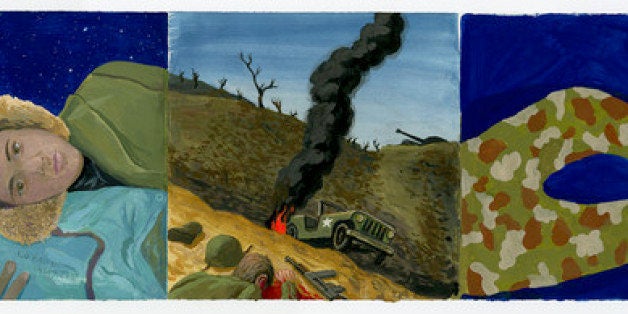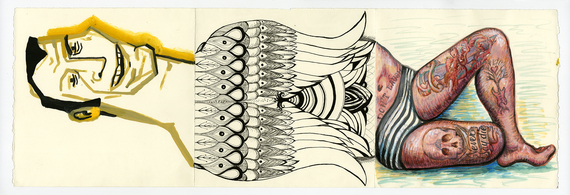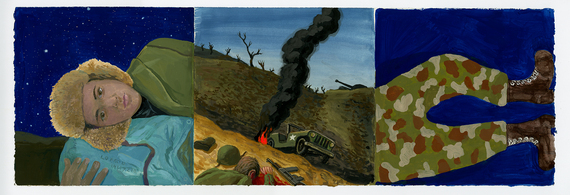
I like to think of it as an elegant Mad Lib, but its real title is the Exquisite Corpse -- or, this time around, the Exquisite Corpse of the Unknown Soldier, part of the "Surrealism & War" exhibit at the National Veterans Art Museum in Chicago. The Exquisite Corpses here are horizontal triptychs, each created by three different artists who added a section of a drawing without knowing what went before. The result is a kind of visual non sequitur, at once alluring and disturbing.
The Exquisite Corpse began as a word game played by the Dadaists. Players contributed a designated part of speech -- a noun, verb, adjective, etc. -- to a piece of paper folded so that they couldn't see what words preceded it. The Surrealists got into the game in the 1920's and contributed the name, which came from the first sentence they created: "The exquisite corpse will drink the new wine." Not bad for what's designed to be nonsense.
The Surrealists also adapted the idea to drawings -- one artist drew the legs; a second, the torso; and a third the head -- and the Corpse has gone through giddy permutations ever since. (I have a kind of flip book version where you can rearrange faces of the English royal family. Somehow, I doubt that's what Breton and Apollinaire had in mind.)
Now, Aaron Hughes, a veteran and the curator of "Surrealism & War," and Jeanne Dunning, an artist and professor at Northwestern University, have taken the concept to a more literal level by asking the initiating artist to choose a specific veteran. It could be anyone who served in the any military at any time, a friend, stranger, or historical figure, living or, in many of the cases, dead.
Nearly 90 artists took part. The images they chose range from the heroic to the horrific. There's John Horse, aka Juan Caballo, a mixed-race resistance fighter during the second Seminole War. Major Nidal Hasan, the army psychiatrist who killed 13 people and wounded many others at Fort Hood. Abed Ibrhen Omran, a 2nd lieutenant who died in Syria the day the artist began her drawing; she couldn't find a picture of him, so she drew the kind of chalk outline you'd find at a homicide scene. Alex Minsky, a U.S. marine badly maimed in Afghanistan, who covered his burns with tattoos and became an underwear model.
There are grandfathers, who did or didn't talk about their wars, and an array of unknowns -- an unknown child of Kosovo, an unknown volunteer, a veteran suicide. One corpse begins with the legs of the artist's father, who earned a Bronze Star in WW II, and ends in Saddam Hussein's head.
These portraits represent real people and real fears -- for their safety, for our dread of the consequences of war. They also embody elements of chance and mystery, harking back to how separate the lives of soldiers seem to most Americans today. "The military may be in our minds but too often the individuals who serve are not," writes Dunning in an essay accompanying the exhibit. "For far too many people, veterans -- what they have gone through, what challenges they face now, even simply who they are -- truly are unknown."
We never leave one of our guys behind on the battlefield, we proclaim proudly. The president just invoked that principle in justifying the prisoner swap that freed Bowe Bergdahl, and his critics too grow teary-eyed over that pledge when it suits their purpose. (We're now getting reports that Bergdahl "walked away" from his unit in disillusionment with its activities in Afghanistan. I wonder how deeply either side of this trumped-up controversy plans to explore the implications of that story.)
The reality is that we leave our soldiers and veterans behind in all sorts of ways, yet these oh-so-exquisite drawings show vividly that they never quite leave us alone.
Should you find yourself in Chicago on 30 August, you too can create an Exquisite Corpse at a workshop accompanying the "Surrealism and War exhibit," which is up through November 1.


